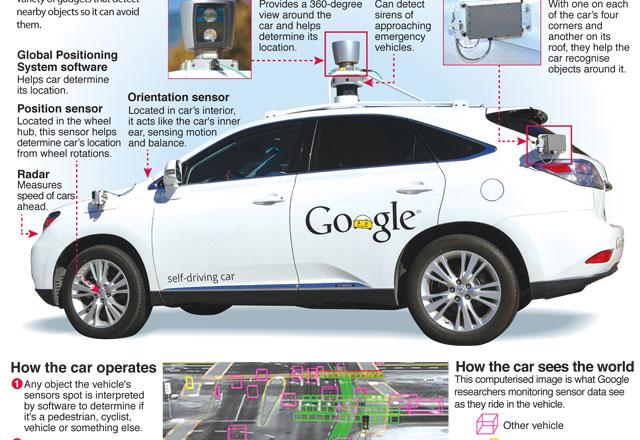You are here
Self-driving cars must learn to deal with bizarre incidents
Dec 02,2014 - Last updated at Dec 02,2014

By Steve Johnson
San Jose Mercury News (MCT)
MOUNTAIN VIEW, California — In 1,126,540 kilometres of navigating roads, Google’s self-driving cars have encountered just about everything — including an elderly woman in a motorised wheelchair flailing a broom at a duck she was chasing around the street.
Apparently perplexed and taking no chances, the vehicle stopped and refused to go farther.
Through extensive testing covering nearly every street in Mountain View, the company’s 20 or so autonomous vehicles have developed an abiding sense of caution. But Google researchers concede it will take more experience on the roads before the autos can learn to cope with every situation without becoming bewildered and shutting down, stranding passengers. When that happens now, researchers have to take the wheel and step on the gas.
One of the most surprising lessons: While hoping to make cars that are safer than those driven by people, Google has discovered its smart machines need to act a little human, especially when dealing with pushy motorists.
“We found that we actually need to be — not aggressive — but assertive” with the vehicles, said Nathaniel Fairfield, technical leader of a team that writes software fixes for problems uncovered during the driving tests. “If you’re always yielding and conservative, basically everybody will just stomp on you all day.”
As a result, he said, Google’s cars on freeways tend to leave a shorter distance between themselves and the vehicles they follow than some driver-training manuals recommend, to discourage other motorists from darting dangerously into the space. And when it’s their turn to proceed at a four-way stop, Fairfield added, Google’s cars will inch forward decisively so other drivers don’t try to beat them through the intersection.
When Google invited a reporter on a half-hour ride to see what the cars have learned, the vehicle carefully cruised through intersections, negotiated construction zones, skirted bicyclists and manoeuvred past other motorists without leaving a scratch.
Driverless cars have been a dream for decades, largely as a way to reduce the carnage on the roads. About 35,000 people die of crashes in the US annually, with 90 per cent of the accidents due to human error, according to the National Safety Council. Google believes its autos could avoid many such mistakes.
Moreover, many experts believe the vehicles could drive bunched together without risk of colliding, reducing traffic congestion and boosting productivity.
Factoring in all its benefits, the technology could save the US economy about $450 billion annually, according to an analysis by the Eno Centre for Transportation, a nonprofit think tank.
The autonomous Navia shuttle, made by the French firm Induct, already shuttles passengers around several overseas college campuses, while London-based Rio Tinto operates more than 50 autonomous trucks at Australian mining sites. And like Google, many car companies are heavily involved in researching the concept. By 2035, 75 per cent of vehicles sold worldwide will have some autonomous capabilities, such as being able to park themselves or drive at least part of a trip on autopilot, Navigant Research predicted in a recent report.
But getting the vehicles to where they need no human intervention will be a major challenge.
A study by corporate adviser KPMG and the Centre for Automotive Research concluded it will be difficult to make a car’s software smart enough to know that a ball bouncing into the street might mean a child could come chasing after it. It’s also unclear who would be liable if a self-driving car caused an accident. And if the cars prove vulnerable to hackers, the study warned, “the nefarious possibilities are mind-boggling.”
Another issue is that Google’s cars require detailed computerised maps of the streets where they operate, prompting concerns that it would be a huge undertaking to create such maps for everywhere the vehicles go.
Google officials acknowledge many issues need to be resolved, but say they’re encouraged by their progress so far.
The company recently began experimenting at NASA’s Ames Research Centre with a two-seat prototype with no steering wheel or other controls other than a stop-and-start button. It also has run its cars through more than 6.4 million kilometres of computer-simulated driving. But most of its actual road tests lately have been in Mountain View, which has plenty of potential hazards, from jaywalkers to people chasing ducks.
Those tests are being done with hybrid Lexus cars modified with radar, video cameras, a rooftop laser and other sensors that see everything around them. Several times when those devices detected a bicyclist or another motorist getting worrisomely close during this reporter’s ride, the vehicle slowed and edged away from the potential danger. And when a big bush blocked its view when it needed to turn, the car proceeded at a snail’s pace around the corner until its sensors got a better view and the car picked up speed again.
On state roads, California requires a person be on hand to take control of the car in emergencies. So on the ride by this reporter, one Googler sat in front, in case he had to grab the steering wheel as occasionally happens when the researchers want to be extra cautious, while another monitored computer data on how the car reacted in different situations. They also tried to assess something a bit more subjective — how well the car got along with other traffic.
“Driving can be a social thing where you’re using your vehicle and a little bit of body language in your car to communicate with other drivers what your intentions are,” said Brian Torcellini, who oversees a group of 50 people who participate in the tests. “So we’re now trying to teach the car different ways to sort of fit in with society and the way that other people drive.”
To date, none of the cars has gotten a traffic ticket or caused an accident, though they’ve been rear-ended by other drivers a couple of times, said Google spokeswoman Katelin Jabbari. That was verified by Bernard Soriano, deputy director of the California Department of Motor Vehicles, adding “we’re pleased” by the safety record.
Company co-founder Sergey Brin has predicted Google’s cars be commercially available as soon as 2017. If so, that probably would be in limited areas for ride-sharing services or others who could operate the cars more economically than individual consumers, said Lawrence Burns, a former General Motors executive who’s now a Google consultant.
But eventually, he expects the cars to become commonplace, assuming they can get enough experience with bizarre situations to handle them without a hitch.
“I’m optimistic,” Burns said. “Every kilo is a chance to discover something unusual.”
Related Articles
SAN FRANCISCO — Google parent Alphabet on Tuesday announced that it has partnered with Fiat Chrysler in a major expansion of its fleet
WASHINGTON/DETROIT — US vehicle safety regulators have said the artificial intelligence system piloting a self-driving Google car coul
DETROIT — Self-driving cars could hit roads within five years, the head of Fiat Chrysler Automobiles said recently, days after the company a














